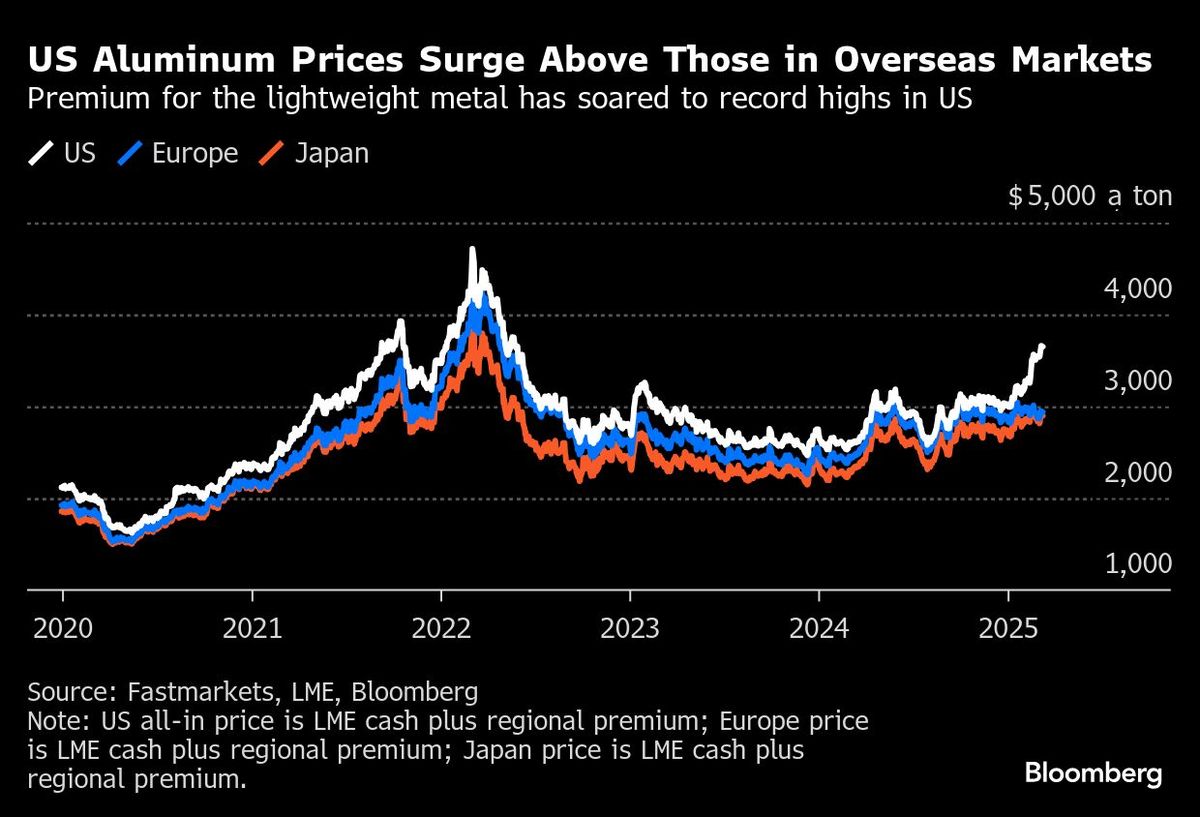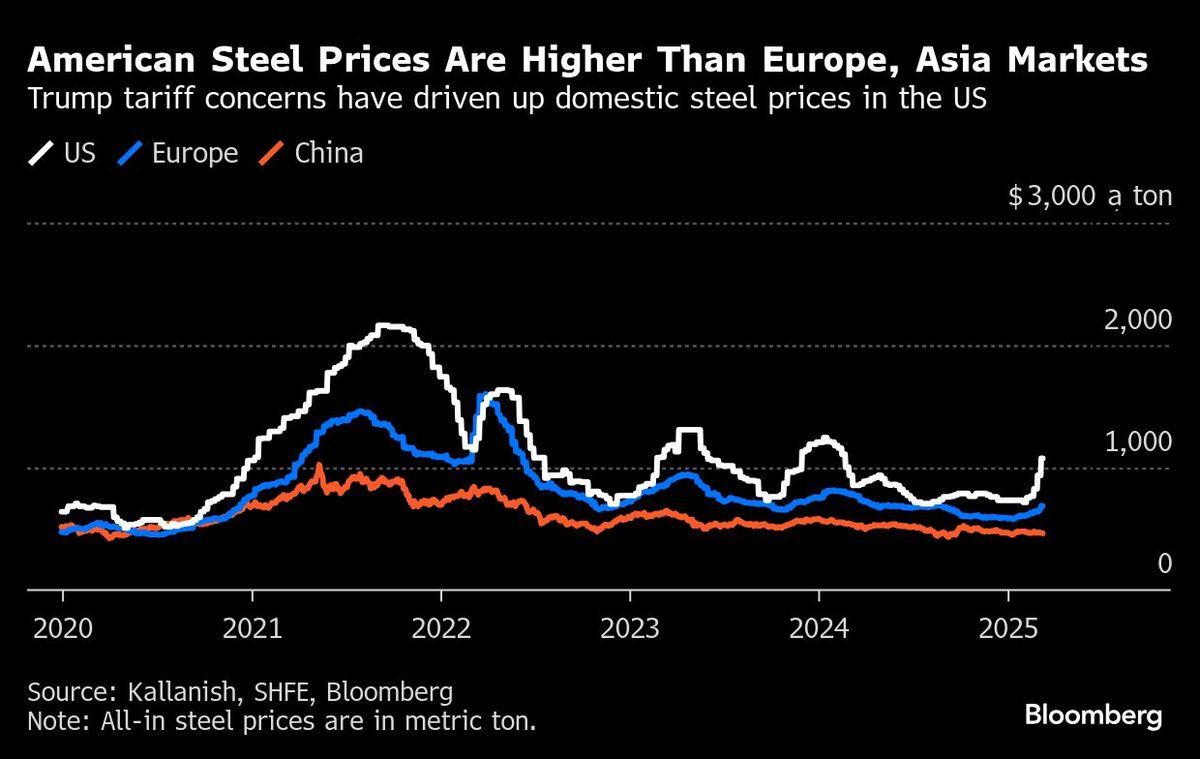
American factories are paying more for aluminium, steel and copper than rival plants overseas after US President Donald Trump imposes tariffs on the metals.
(March 12): American manufacturers are paying much higher prices for aluminium, steel and copper than rival plants overseas, in a trend that’s sapping business confidence and stoking worries about inflation even before tariffs on metals come into effect.
US prices for the three key industrial raw materials have been ratcheting higher for weeks, partly driven by manufacturers’ efforts to build up stocks before US President Donald Trump imposes tariffs on the metals. In the process, they’ve decoupled from prices that manufacturers are paying in other major industrial economies including China, Germany and Japan.
For aluminium consumers, prices to get spot supplies are about 23% higher than in Europe. Steel prices are about 40% more — exceeding the 25% levy that Trump plans to slap on both metals on Wednesday. In the copper market, where tariffs could be months away, US manufacturers are already paying about 10% more than European buyers, according to Bloomberg calculations.
Such extra charges don’t take into account Trump’s Tuesday announcement that he’d boost tariffs on Canadian steel and aluminium to 50% on March 12 to retaliate against Ontario’s move to raise taxes on electricity sent to the US.
The surcharges have upended global metal markets as traders rushed to lock in profits by shipping cargoes to the US before tariffs are imposed. But for manufacturers, the anticipatory spike in prices fueled by Trump’s trade agenda has created significant commercial headwinds that risk leaving them at a growing disadvantage to rivals abroad.
“Customers are concerned, and they’re all wondering how the costs are going to affect their end products,” said Dan Markham, president of Markham Metals Inc, a Wilmington, Massachusetts-based manufacturer and distributor of aluminium and steel. The executive said he’s already seeing higher prices, and they’re getting passed along. “Our customers pay more.”
Aluminium premiums, which consumers pay over and above exchange prices, have soared to record highs in the US. That means that the price of a standard aluminium ingot for US buyers has jumped 20% since the start of the year to the highest in nearly three years, even as prices in Europe have been broadly flat.
For American steel, the benchmark price touched more than US$900 (RM3,970) a tonne at the end of February, and is up more than 30% this year, in anticipation of a tariff on foreign supplies. Trump sees such tariffs as boosting American production in the long term, though there’s mounting evidence that consumers will be footing the bill in the short term.
“You’re going to see this surge in prices in the near term and that will incentivise US steel production and higher prices,” Hamad Hussain from Capital Economics said in an interview. “You’re going to see this higher price surge, then prices will level off along the way.”
Trump’s plan to impose tariffs on steel and aluminium imports is unlikely to arrest decades of declining market share and stagnating production, if the past is any guide. The materials were among Trump’s earliest tariffs during his first term, implementing a 25% duty on steel and a 10% duty on aluminium in 2018. Since then, there has been little change in American steel output while US aluminium production has further declined amid idling of domestic smelters.
The flow of copper around the world is already being altered by Trump’s tariff threats, even though the wiring metal is not on the tariff list yet. The US president in late February ordered the Commerce Department to conduct a probe into possible tariffs on national security grounds. Such investigations typically take months.
Goldman Sachs Group Inc analysts expect all forms of copper shipped to the US to be hit with a 25% tariff, keeping prices on New York’s Comex trading at a hefty premium over other benchmarks.
The import tariff is expected to “fully pass through into US domestic prices, with Comex to trade at a sustained premium” to the London Metal Exchange, analysts led by Eoin Dinsmore said in a March 1 note.
Uploaded by Felyx Teoh
- Embattled billionaire Ong Beng Seng’s firm to be run by veteran executives
- Jentayu signs 40-year power purchase agreement for RM2.8b 162MW Sabah hydropower project
- Majujaya files petition to wind up Bina Puri for failure to pay RM30m awarded by court
- Trump warns tariffs coming for electronics after reprieve
- Singapore eases monetary policy as expected, sees weaker growth in 2025
- Sony hikes PlayStation 5 price by 11% in Europe
- Goldman’s stock traders ride volatile markets to record quarter
- Reach Energy faces trading suspension, possible delisting, as Bursa rejects third extension request
- Ex-PM Tun Abdullah Ahmad Badawi passed away at IJN at 7.10pm today, says Khairy
- Malaysian Bar defends Chief Justice amid backlash from former law minister over judicial reform remarks



